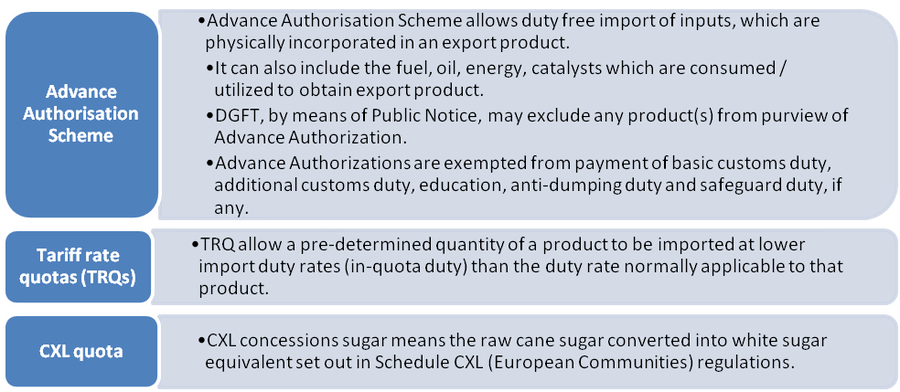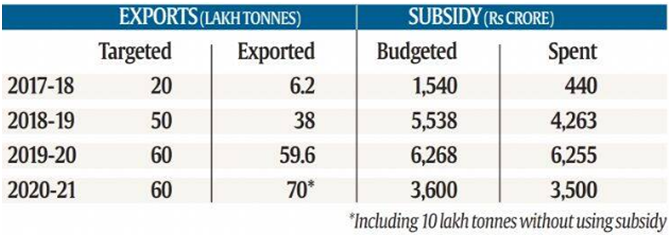Context
- The government has notified that sugar exports will be restricted, or allowed only with permission of the Directorate of Sugar, Department of Food and Public Distribution under Ministry of Consumer Affairs.
- The government has capped sugar exports at 10 million tonnes with effect from 1st June, 2022 till 31st October, 2022.
About latest sugar curbs
- The government has moved export of sugar from the ‘open category’, which requires no government intervention, to ‘restricted’ category, the first such move in four years.
- The permission to export would be required for both the pending contracted quantity and any new contracts entered by mills.
- Unlike wheat, where export has been banned, sugar would continue to be exported, but from June 1, permission would be required to send the shipments out.
- Sugar mills, hence, need to seek permits from the directorate of sugar to ship out the sweetener and file details of despatches with the directorate’s portal daily.
- However, re-exports of refined sugar, made from raw sugar imported under the Advance Authorisation Scheme, may not require prior permission.
- This export restriction is also not applicable to EU and the US, under the CXL and Tariff-Rate Quota(TRQ) India has allowed sugar exports of 5,841 tonnes to the EU and 10,475 tonnes to the US under the TRQ and CXL quotas.

India’s sugar estimates
- India is the biggest producer of sugar and the second largest exporter after Brazil.
- Before the start of the sugar season (October to September every year), the central government announces both the quota for export and the subsidy to achieve the target.
- India's sugar exports had increased to $4.6 billion (about Rs 35,000 crore) in 2021-22 from $1.17 billion (about Rs 9,000 crore) in 2013-14.

- The current season (2021-22) has seen millers enter into contracts to export 90 lakh tonnes of sugar. Out of this, 71 lakh tonnes of sugar has already left the country. The consignments scheduled to leave after June 1 will need government permission.
Estimated sugar output during the sugar season 2021-22 (October-September)
- The country has seen a bumper sugarcane crop. Of the 521 mills engaged in cane crushing this season, 116 mills are still operating with Maharashtra leading.
- The sugar industry estimates the production of 350 lakh tonnes of sugar this season.
- Around 34 lakh tonnes of sugar has already been subsumed for production of ethanol. India’s domestic consumption is pegged at 260 lakh tonnes.
Reasons for India’s booming sugar exports
- India’s sugar exports grew over the last few seasons due to the fact that Brazil produced more ethanol than sugar given the exceptional rise in fuel prices.
- Moreover, other big sugar producers like Thailand were hit by drought which helped India venture in countries which otherwise were dependent on Brazilian sugar.
- Also, owing to global surge in food prices, demand for India’s raw sugar increased substantially.
- Government also asked domestic sugar mills to export sugar and sign forward contracts with the importers to take advantage of high international prices of sugar in August 2021.
Reasons for curb on sugar export
- Domestic availability:Government fears that unhindered exports could potentially create a shortage in the market and push up prices, especially towards the end of the current year and ahead of the festival season in October-November.
- Back-up stocks:The sugar season officially starts in October, but picks up momentum only after December. If there is scarcity of back-up stocks during this period then prices can escalate in the domestic market. This ban is a precautionary move to keep domestic supplies steady until production from the next season’s crop hits the market.
- Utilising previous stocks:Cane crushing season starts in the last week of October in Karnataka and Maharashtra and in November in Uttar Pradesh. So, up to November, the supply of sugar typically takes place from the previous year’s stocks.
- The decision will ensure that the closing stock of sugar at the end of the current marketing year (September 30) remains 60-65 LT, which is enough for 2-3 months’ of consumption (the monthly requirement is about 24 LT in those months).
- Exports breach target: Since 2010-11, India has consistently produced surplus sugar, comfortably exceeding the domestic requirements. However,in the sugar season 2020-21 against a target of 60 LMT about 70 LMT of sugar have been exported. The government has expressed its concerns regarding this and said that the move to restrict sugar export was aimed at safeguarding the interests of consumers and keep the prices in check.
- Price stability: Retail sugar prices have been almost stagnant year-on -year hovering between Rs 39.50 to Rs 41 per kg. However,it can see inflation if the October opening stock is anything less than 65-70 lakh tonnes.
- Curb inflation: India’s retail inflation has been above RBI’s tolerance band for the fourth straight month in April, and is likely to continue in the coming months too.
- Prevent hoarding: Commerce and Industry Minister at WEF recently said that the government didn’t want any surplus to go into the hands of hoarders who would then charge a huge amount from poorer nations.
Implications of curb on sugar export
- No worrisome situation: National Cooperative Sugar Factories Federation, believes that India would end up exporting around 100 lakh tonnes of sugar this season even with the curbs.
- Push up global prices:India exported sugar to 121 countries across the globe and recent curbs on exports may further flame global food prices.
- Dip in stocks: Most sugar stocks have plummeted 30 to 40 per cent from 52-week highs owing to the ban, thus hurting investors.
- Boost ethanol production: The export restrictions will make more surplus sweetener (sugar) accessible for domestic ethanol production, which is a primary government aim as per National Biofuel Policy.
- Company Profitability: Increased cane diversion to ethanol will alleviate the problem of excess sugar inventories and minimize company volatility, resulting in improved profitability, lower working capital, and stronger long-term cash flows.










